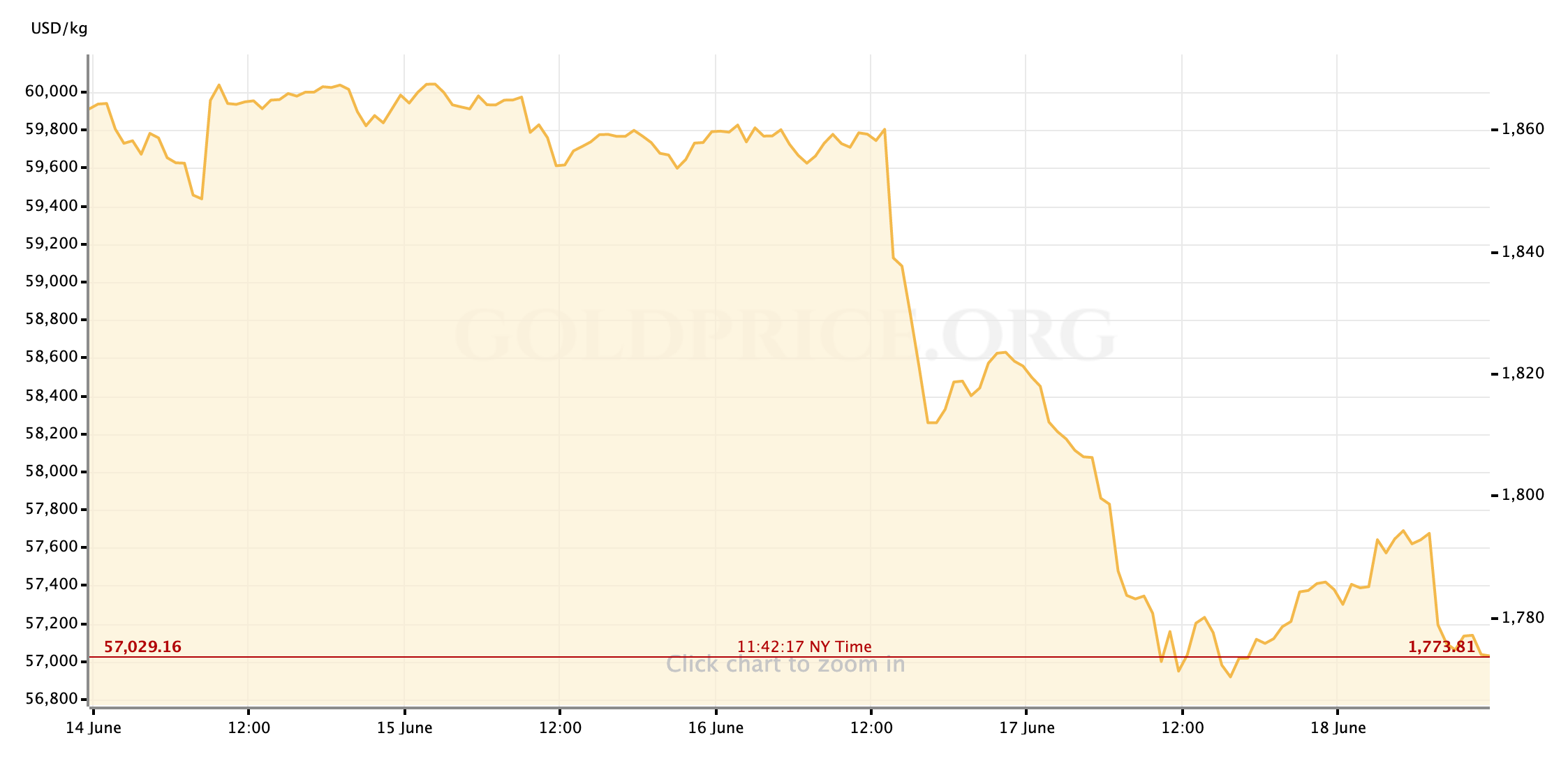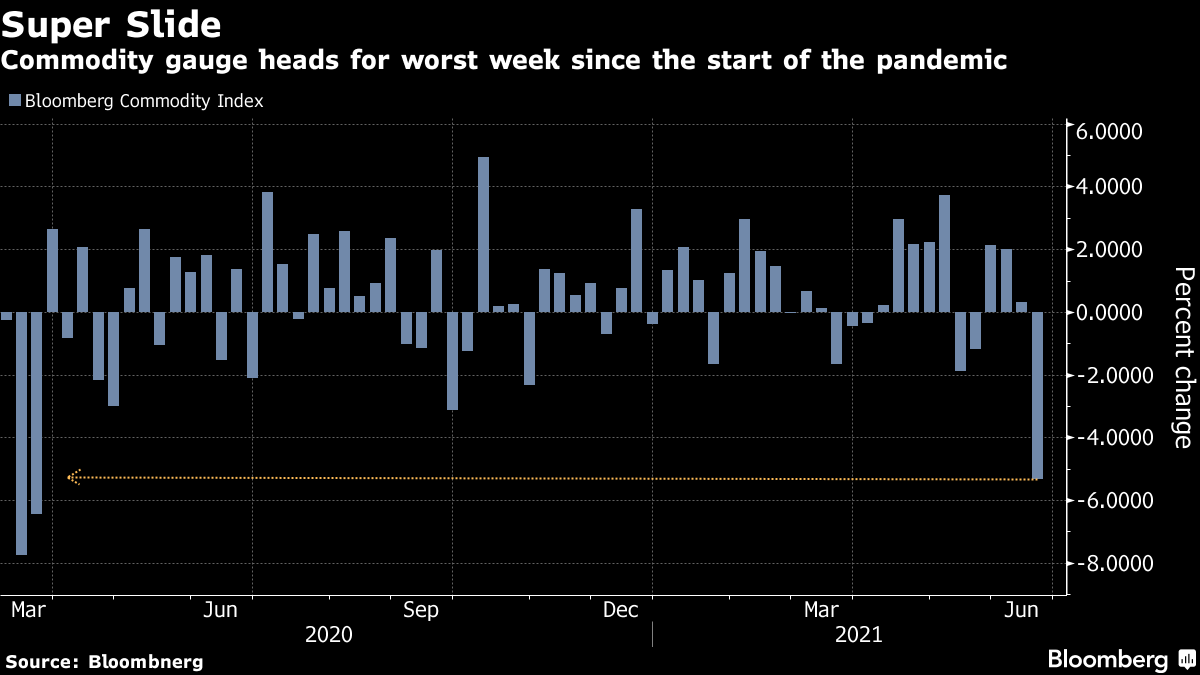Happy Friday, traders. Welcome to our weekly market wrap, where we take a look back at these last five trading days with a focus on the market news, economic data and headlines that had the most impact on gold prices—and may continue to into the future—as well as the charts for silver, the US Dollar and other key correlated assets.
Gold prices have collapsed this week, following an unexpected hawkish tilt from the Fed this week.

Although the first bit of distance from Wednesday’s FOMC meeting has allowed investors to begin correcting what may have been an overreaction to news from the Fed, gold and the other core commodities have suffered the brunt of the markets’ knee-jerk reactions and may have to spend the summer looking for a life-preserver to keep hopes of a 2021 rally afloat.
So, what kind of week has it been?
This week’s FOMC meeting culminated in two major reveals from the Federal Reserve’s policy making committee. While it would be easy to characterize this as “The Fed blinked,” that’s overly dramatic for what ultimately signals a small shift central bank’s active stance. A shift that was expected to come at some point, at that. Of the two most talked about policy points from the FOMC, only one will have a tangible impact on the US economy and markets in the near- to medium-term. The other, while obviously exerting an immediate impact on markets, may not ever come into form enough to affect the economy.
- Which part of the FOMC announcement is likely to have a real impact? In his post-FOMC press conference, Chairman Powell referred to this week’s meeting as “the ‘talking about talking about’ meeting” with regards to the Fed’s eventual move to tapering-off its current (massive) operation of asset purchases in support of the US economy.
- According to the Fed’s current framework and consistent forward guidance since cutting the short-term interest rate to 0%, tapering-off the assert purchase operations will be a compulsory first step preceding a rate hike.
- This aligns well with the general consensus that—assuming the current trajectory of the US recovery remains more or less constant—the Fed will use the platform of its annual Jackson Hole symposium later this summer to announce its plans to tapper asset purchases, before initiating the tapper at the end of the year (probably December.)
- The reason we can say this bit of news is relevant to both the markets and the US economy is that it is a case of the Fed commenting on plans within a relatively short time-frame. That is: we can expect the makeup of the FOMC and the general trend of the US economic recovery to be roughly the same in August and December as it is today.
- Which part of the FOMC announcement did the market immediately react to? Looking at the dot plot, the projected rate path of the “median FOMC participant” has accelerated and now anticipates two rate hikes before the end of 2023, where the prior set of economic projections called for none.
- This is the change that inflation hawks and/or general Fed-skeptics can point to as the central bank wavering a bit on their assertion that the current spike in inflation will ultimately be temporary: it’s presumed that the expectation that the Fed of the future will need to raise rates earlier is based on this recent acceleration.
- Time is the reason that this particular change might ultimately be meaningless, of course: By early-to-mid-2023 (if not before,) the makeup of the FOMC may have changed significantly; Or the real economic situation at the time may not look much like today’s projections.
- However, the shift in the median dot doesn’t really look like an acute reaction to the recent months’ inflation surge at all, but rather to the idea that the broader US economic recovery could potentially move faster than expected. We can see this in the Fed’s updated projections for price inflation: Participants’ median projection for inflation at the end of 2021 is sharply higher than in March, but the estimated rate of inflation for 2022 & 2023 only moved up by 0.1% each. Even here, the Fed appears still committed to its estimation that current inflationary pressures will pass.
So how did the markets react? If forward-looking logic and reason were not a core component of Wednesday’s market action, momentum certainly was. Precious metals prices collapsed alongside Treasury bonds, equities markets spasmed and—perhaps most importantly for the long run—the US Dollar ripped higher.
- Having been calm as most asset classes while investors and managers awaited the Fed, the midday FOMC announcement pulled the floor out from under gold and prices found little more than air pockets from that point on. The yellow metal shed roughly $20/oz in the spot markets, briefly stabilized ahead of Powell’s press conference, and then by the end of the Chair’s Q&A the chart had collapsed again, to a temporary floor of $1810.
- Silver followed gold’s trading patter, as did most of the broader commodities complex. Raw materials were as a whole may have borne the brunt of this Fed Week.
- The US stock market took a sharp initial tumble as well, as equities seem to generally react very poorly in this current environment to any discussions about the Fed tightening financial conditions at some point in the future. After the initial reactions though, with investors given time to parse the FOMC statement and Powell’s remarks and the still long-time horizon of any rate hikes, the major indexes calmed. All three benchmarks would still turn in losses on the day, but by the close of trading had pared back most of their post-FOMC loses.

- Unsurprisingly, yields on US Treasuries spiked following Wednesday’s Fed news, breaking as high as 1.56% for the 10-year Note. The most meaningful move has been in the US Dollar however. That the Dollar’s central bank on Wednesday just put theoretical rate hikes on the calendar elevated the Greenback above most of its trading partners in terms of storing value long term. The Dollar Index hasn’t looked back since taking off post-FOMC and trades on Friday at its highest levels in more than two months,
Through the end of the week, USD’s resurgence has been directly impacting the current performance of gold and other key commodities, as well as their potential for recovery this summer. Following a brief pause during Thursday’s session in Asia, the Dollar’s continued acceleration the day after FOMC heaped persistent pressure on gold prices, even as US equities fared better on the day. Gold found little support even at the $1800 level and slid throughout Thursday’s session to the current levels of active support around $1770/oz.
- Indeed, it’s continued to be an ugly week for commodities as a whole. Although equities are holding on to the majority of gains made this year as part of the broad US reflation trade, as of Friday morning the overall commodities complex has given back most of 2021’s upward progress.

As we look ahead to final trading weeks of June, the gold market is in an interesting (if unclear) position. By most technical measures, gold prices are dramatically “oversold” at this point and, given the right catalyst, could be ripe for a rebound. The question for the summer, however, is what could that catalyst be? It will need to be something convincing enough to break through—if not actively reverse—the Dollar’s resurgence, and may well need to pull the overall commodities complex higher in order to see gold spot prices return to $1850 or higher. That kind of “shock,” if it comes, will probably have to be exogenous and not something we’ll see coming.
For now, traders, I hope you can get out and safely enjoy your weekend for the next couple of days. After that, I’ll see everyone back here on Monday for our preview of the week ahead.













